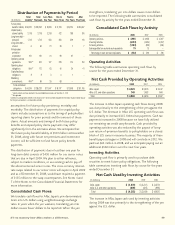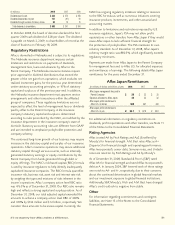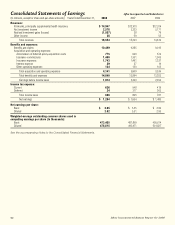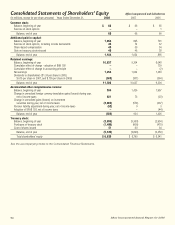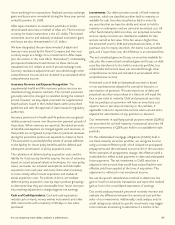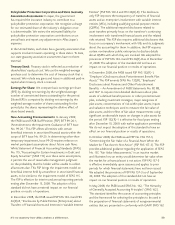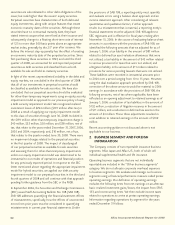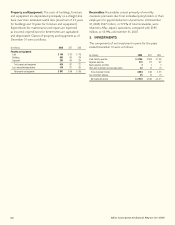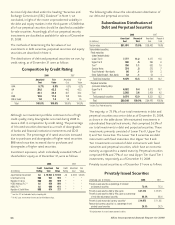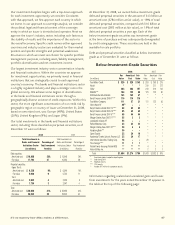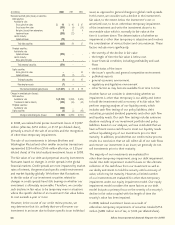Aflac 2008 Annual Report Download - page 63
Download and view the complete annual report
Please find page 63 of the 2008 Aflac annual report below. You can navigate through the pages in the report by either clicking on the pages listed below, or by using the keyword search tool below to find specific information within the annual report.
59
It’s no mystery how Aflac makes a difference.
Policyholder Protection Corporation and State Guaranty
Association Assessments: In Japan, the government
has required the insurance industry to contribute to a
policyholder protection corporation. We recognize a charge
for our estimated share of the industry’s obligation once
it is determinable. We review the estimated liability for
policyholder protection corporation contributions on an
annual basis and report any adjustments in Aflac Japan’s
expenses.
In the United States, each state has a guaranty association that
supports insolvent insurers operating in those states. To date,
our state guaranty association assessments have not been
material.
Treasury Stock: Treasury stock is reflected as a reduction of
shareholders’ equity at cost. We use the weighted-average
purchase cost to determine the cost of treasury stock that is
reissued. We include any gains and losses in additional paid-in
capital when treasury stock is reissued.
Earnings Per Share: We compute basic earnings per share
(EPS) by dividing net earnings by the weighted-average
number of unrestricted shares outstanding for the period.
Diluted EPS is computed by dividing net earnings by the
weighted-average number of shares outstanding for the
period plus the shares representing the dilutive effect of
share-based awards.
New Accounting Pronouncements: In January 2009,
the FASB issued FASB Staff Position (FSP) EITF 99-20-1,
“Amendments to the Impairment Guidance of EITF Issue
No. 99-20.” This FSP affects all entities with certain
beneficial interests in securitized financial assets within the
scope of EITF Issue No. 99-20. In determining other-than-
temporary-impairment, Issue 99-20 requires reliance on
market participant assumptions about future cash flows.
While Statement of Financial Accounting Standards (SFAS)
No. 115, “Accounting for Certain Investments in Debt and
Equity Securities” (SFAS 115) uses these same assumptions,
it permits the use of reasonable management judgment
on the probability that the holder will be unable to collect
all amounts due. This FSP brings the impairment model on
beneficial interest held by a transferor in securitized financial
assets, to be similar to the impairment model of SFAS 115.
The FSP is effective for interim and annual reporting periods
ending after December 15, 2008. The adoption of this
standard did not have a material impact on our financial
position or results of operations.
In December 2008, the FASB issued FSP FAS 140-4 and FIN
46(R)-8, “Disclosures by Public Entities (Enterprises) about
Transfers of Financial Assets and Interests in Variable Interest
Entities” (FSP FAS 140-4 and FIN 46(R)-8). This disclosure-
only FSP improves the transparency of transfers of financial
assets and an enterprise’s involvement with variable interest
entities (VIEs), including qualifying special-purpose entities
(QSPEs). The additional required disclosures related to
asset transfers primarily focus on the transferor’s continuing
involvement with transferred financial assets and the related
risks retained. This FSP also requires additional disclosures that
focus on a company’s involvement with VIEs and its judgments
about the accounting for them. In addition, the FSP requires
certain nontransferor public enterprises to disclose details
about QSPEs with which they are involved. We adopted the
provisions of FSP FAS 140-4 and FIN 46(R)-8 as of December
31, 2008. The adoption of this standard did not have an
impact on our financial position or results of operations.
In December 2008, the FASB issued FSP FAS 132(R)-1,
“Employer’s Disclosures about Postretirement Benefit Plan
Assets.” This FSP amends SFAS No. 132(R), “Employers’
Disclosures about Pensions and Other Postretirement
Benefits — An Amendment of FASB Statements No. 87, 88,
and 106” to require more detailed disclosures about plan
assets of a defined benefit pension or other postretirement
plan, including investment strategies; major categories of
plan assets; concentrations of risk within plan assets; inputs
and valuation techniques used to measure the fair value of
plan assets; and the effect of fair-value measurements using
significant unobservable inputs on changes in plan assets for
the period. FSP 132(R)-1 is effective for fiscal years ending
after December 15, 2009, with earlier application permitted.
We do not expect the adoption of this standard to have an
effect on our financial position or results of operations.
In October 2008, the FASB issued FSP No. FAS 157-3,
“Determining the Fair Value of a Financial Asset When the
Market for That Asset Is Not Active” (FSP FAS 157-3). This FSP
provides additional guidance regarding the application of SFAS
No. 157, “Fair Value Measurements,” in an inactive market
and illustrates how an entity would determine fair value when
the market for a financial asset is not active. FSP FAS 157-3
is effective immediately upon issuance and applies to prior
periods for which financial statements have not been issued.
We adopted the provisions of FSP FAS 157-3 as of September
30, 2008. The adoption of this standard did not have an
impact on our financial position or results of operations.
In May 2008, the FASB issued SFAS No. 162, “The Hierarchy
of Generally Accepted Accounting Principles” (SFAS 162).
This standard identifies the sources of accounting principles
and the framework for selecting the principles to be used in
the preparation of financial statements of nongovernmental
entities that are presented in conformity with GAAP. SFAS 162


